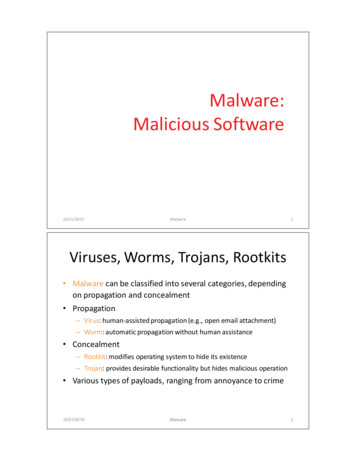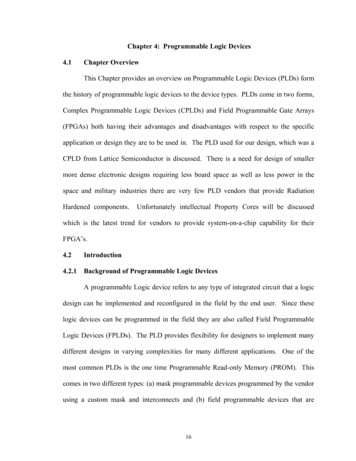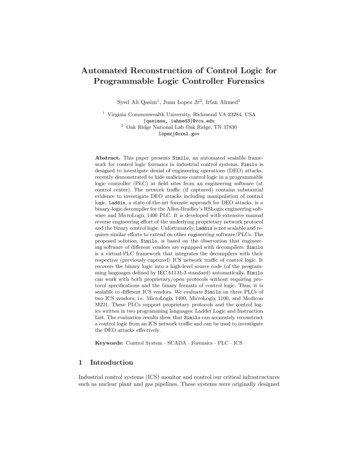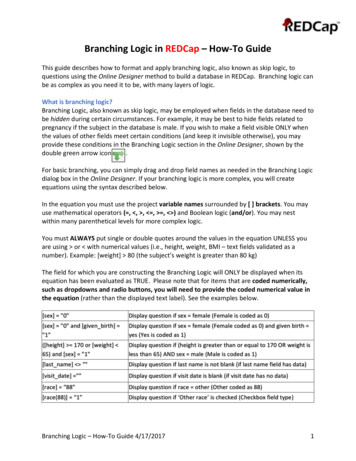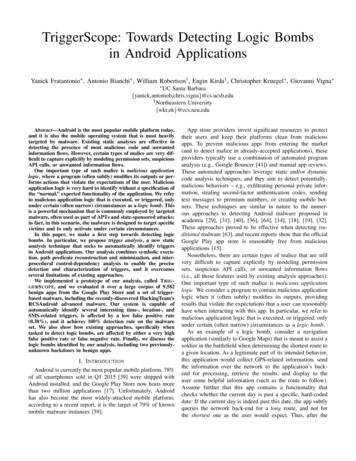
Transcription
TriggerScope: Towards Detecting Logic Bombsin Android ApplicationsYanick Fratantonio , Antonio Bianchi , William Robertson† , Engin Kirda† , Christopher Kruegel , Giovanni Vigna UCSanta � Northeastern University{wkr,ek}@ccs.neu.eduAbstract—Android is the most popular mobile platform today,and it is also the mobile operating system that is most heavilytargeted by malware. Existing static analyses are effective indetecting the presence of most malicious code and unwantedinformation flows. However, certain types of malice are very difficult to capture explicitly by modeling permission sets, suspiciousAPI calls, or unwanted information flows.One important type of such malice is malicious applicationlogic, where a program (often subtly) modifies its outputs or performs actions that violate the expectations of the user. Maliciousapplication logic is very hard to identify without a specification ofthe “normal,” expected functionality of the application. We referto malicious application logic that is executed, or triggered, onlyunder certain (often narrow) circumstances as a logic bomb. Thisis a powerful mechanism that is commonly employed by targetedmalware, often used as part of APTs and state-sponsored attacks:in fact, in this scenario, the malware is designed to target specificvictims and to only activate under certain circumstances.In this paper, we make a first step towards detecting logicbombs. In particular, we propose trigger analysis, a new staticanalysis technique that seeks to automatically identify triggersin Android applications. Our analysis combines symbolic execution, path predicate reconstruction and minimization, and interprocedural control-dependency analysis to enable the precisedetection and characterization of triggers, and it overcomesseveral limitations of existing approaches.We implemented a prototype of our analysis, called T RIG GER S COPE , and we evaluated it over a large corpus of 9,582benign apps from the Google Play Store and a set of triggerbased malware, including the recently-discovered HackingTeam’sRCSAndroid advanced malware. Our system is capable ofautomatically identify several interesting time-, location-, andSMS-related triggers, is affected by a low false positive rate(0.38%), and it achieves 100% detection rate on the malwareset. We also show how existing approaches, specifically whentasked to detect logic bombs, are affected by either a very highfalse positive rate or false negative rate. Finally, we discuss thelogic bombs identified by our analysis, including two previouslyunknown backdoors in benign apps.I. I NTRODUCTIONAndroid is currently the most popular mobile platform. 78%of all smartphones sold in Q1 2015 [39] were shipped withAndroid installed, and the Google Play Store now hosts morethan two million applications [17]. Unfortunately, Androidhas also become the most widely-attacked mobile platform;according to a recent report, it is the target of 79% of knownmobile malware instances [59].App store providers invest significant resources to protecttheir users and keep their platforms clean from maliciousapps. To prevent malicious apps from entering the market(and to detect malice in already-accepted applications), theseproviders typically use a combination of automated programanalysis (e.g., Google Bouncer [41]) and manual app reviews.These automated approaches leverage static and/or dynamiccode analysis techniques, and they aim to detect potentiallymalicious behaviors – e.g., exfiltrating personal private information, stealing second-factor authentication codes, sendingtext messages to premium numbers, or creating mobile botnets. These techniques are similar in nature to the numerous approaches to detecting Android malware proposed inacademia [29], [31], [40], [36], [64], [14], [18], [19], [32].These approaches proved to be effective when detecting traditional malware [63], and recent reports show that the officialGoogle Play app store is reasonably free from maliciousapplications [15].Nonetheless, there are certain types of malice that are stillvery difficult to capture explicitly by modeling permissionsets, suspicious API calls, or unwanted information flows(i.e., all those features used by existing analysis approaches).One important type of such malice is malicious applicationlogic. We consider a program to contain malicious applicationlogic when it (often subtly) modifies its outputs, providingresults that violate the expectations that a user can reasonablyhave when interacting with this app. In particular, we refer tomalicious application logic that is executed, or triggered, onlyunder certain (often narrow) circumstances as a logic bomb.As an example of a logic bomb, consider a navigationapplication (similarly to Google Maps) that is meant to assist asoldier in the battlefield when determining the shortest route toa given location. As a legitimate part of its intended behavior,this application would collect GPS-related information, sendthe information over the network to the application’s backend for processing, retrieve the results, and display to theuser some helpful information (such as the route to follow).Assume further that this app contains a functionality thatchecks whether the current day is past a specific, hard-codeddate: If the current day is indeed past this date, the app subtlyqueries the network back-end for a long route, and not forthe shortest one as the user would expect. Thus, after the
123456789101112131415161718public void f() {Date now new Date();Date target new Date(12,22,2016);// 1) retrieve GPS coordinates;.if (now.after(target)) {// 2) query network back-end//for a *long* routeg();} else {// 2) query network back-end//for the *shortest* route//(as expected)h();}// 3) show computed route to user.}Figure 1: A possible implementation of a logic bomb.hard-coded date, this application would provide misleadinginformation, and the results could seriously affect the wellbeing of the user. Figure 1 shows a possible implementationof this behavior.While traditional malware rarely implements this kind ofstealthy behavior, these techniques are often used by targetedmalware employed by APT actors when executing targeted,state-sponsored attacks. In fact, in this scenario, malwareis designed to target specific victims and to only activateunder certain circumstances. Unfortunately, targeted malwareare becoming more prevalent. As a clear example, in July2015 the HackingTeam security company was victim of asophisticated attack [56], and all its internal resources andpersonal communications got publicly leaked: This attack ledto the identification of RCSAndroid [60], one of the mostsophisticated malware sample for Android ever discovered.This malware has the ability to leak the victim’s private conversations, GPS location, and device tracking information, butit is also able to capture screenshots, collect information aboutonline accounts, and capture real-time voice calls. However,these malicious behaviors are not manifested when the application starts. Instead, to increase its stealthiness, RCSAndroidwaits for incoming SMS messages and checks whether thesemessages are sent from specific senders and contain specificcommands. While this application was officially sold to lawenforcements agencies and governments, the HackingTeamcompany has been accused by anti-surveillance campaignersof collaborating with governments with poor human rightsrecords [57], and also in conducting targeted attacks againstactivists [58]. In particular, RCSAndroid’s usage in the wildis documented by several (now public) internal communications [7], [5], [6].Another scenario where trigger-based malware poses a realthreat is related to the Android app store curated by the U.S.Department of Defense [26], which collects applications toassist officers and soldiers in the battlefield. The DoD marketplace features applications that are internally-developed butalso many applications developed by government contractorsand third parties, such as commercial entities. The currentsolution to finding malicious application logic is manual audit,often in combination with dynamic analysis. That is, to vet anapplication, a human analyst executes the program in an instrumented environment and studies its behavior under variousinputs. In this model, the analyst’s own judgment and the app’sdescription serve as the guidelines to help determine whetherthe program functions as expected. Unfortunately, even thiscostly (both in terms of time and labor) manual process doesnot guarantee the identification of logic bombs, especially forthose cases where the source code is not available (e.g., GoogleMaps).Logic bombs are particularly insidious, since they can eludestatic analysis efforts and are hard to detect for human analysts,even when equipped with powerful dynamic analysis tools. Infact, consider the example in Figure 1. When examining thisapplication, a static analysis system will not find any unusualpermission or unwanted API calls, or any clearly-maliciousaction (in fact, invoking network-related APIs is perfectlylegitimate for a navigation app), thereby bypassing traditionalapproaches such as [31], [18], [36], [64]. Also, all informationflows (e.g., location-related source flows to a network sink)are expected, as they correspond to the description of the appin the store, rendering ineffective the detection capabilitiesprovided by [19], [35]. Approaches based on dynamic analysis [41], [29], [40], [53], [49], [55] are ineffective as well: sincethe hardcoded date is set in the future, the time-related checkwill not be satisfied when testing the app, and the maliciousfunctionality will thus not be executed. As another example,an app could run its malicious behavior only when the useris in a particular location. Unfortunately, these techniques areactively being used to bypass automatic and manual vettingsystems [10], [1].The key challenge is related to the fact that automaticallydetecting malicious application logic is very hard withouttaking into account the specific purpose and “normal” functionality of an application, and, hence, it is out of reachfor most existing analysis tools. In fact, even those dynamicanalysis tools designed to increase the code coverage (e.g.,approaches based on multipath execution and/or dynamic symbolic execution [43], [22], [34], [8], [42], [61], [48]) would nothave access to enough information to discern whether the justexecuted functionality was malicious or not. At the very least,these tools would require a very fine-grained specification ofthe intended app behavior, something that is typically notavailable.In this paper, we make a first step towards the automaticdetection of logic bombs. Our work is based on the following key observation: an aspect that, at least in principle, isnecessary for the implementation of a logic bomb is thatthe malicious behavior is triggered only under very specificcircumstances. Thus, in this work we propose to detect logicbombs by precisely analyzing and characterizing the checksthat guard a given behavior, and to give less importance to thebehavior itself. To this end, we developed a new static analysis
technique, called trigger analysis, which combines traditionalprogram analysis techniques with novel elements used forautomatically and precisely identifying triggers. We (informally) define triggers as suspicious predicates (or checks)over program inputs that guard the execution of potentiallysensitive behavior, where a predicate is (intuitively) consideredas suspicious if it is satisfied only under very specific conditions. In particular, we use static code analysis and symbolicexecution to first identify checks that operate on sensitiveinput, and to then extract their precise semantics (i.e., whichinputs are used, what operations were performed on theseinputs, and what values are they compared against). We thenuse path predicate reconstruction, path predicate minimization,and predicate classification to identify interesting checks, and,as a last step, the analysis performs inter-procedural controldependency analysis to determine whether a specific checkguards sensitive operations.We propose to use trigger analysis for the identification oflogic bombs. However, of course, not every trigger (accordingto our definition) is part of a logic bomb. As a result, thefact that an app contains a trigger is typically not enough tooutright convict an application as being malicious. However,we show in our experiments that a detection system that flagsall applications that contain an interesting trigger as malicious,delivers excellent detection results for targeted malware, whileraising a very small number of false positives on benign apps(outperforming existing malware detection systems that focuson opportunistic malware). Our system also returns a seriesof detailed information for each of the detected trigger, thusgoing beyond the mere identification of each of them. Thisgreatly simplifies the work of a human analyst who has tomake the decision whether a trigger is acceptable or malicious.Moreover, the output of our analysis can be also used as astarting point to craft inputs for a dynamic analysis system toexercise and vet the relevant behavior.We have implemented our trigger analysis in a system calledT RIGGER S COPE. Our analysis operates directly on Dalvikbytecode, and it does not rely on access to source code. Ourcurrent prototype handles a number of different program inputsthat have been traditionally used to activate malicious behavior: time, location, and the content (and sender) of text messages (SMS). We have extensively evaluated T RIGGER S COPEover a large corpus of benign and malicious applications. Ourbenign dataset is constituted by 9,582 Android applicationsdownloaded from the Google Play Store, while our maliciousdataset is constituted by several malicious apps that were eitherdeveloped by an independent DARPA Red Team organization(developed with the aim of resembling state-sponsored malware) or real-world malware samples containing logic bombs,including the HackingTeam’s RCSAndroid application.Our experiments demonstrate the ability of our system toprecisely and efficiently detect triggered behavior in theseapplications. In particular, T RIGGER S COPE was able to automatically identify several interesting triggers, including twopreviously-unknown backdoors in supposedly-benign apps,and a variety of logic bombs in the malicious samples. T RIG -GER S COPE ’s output also proved to be useful for constructingproof-of-concepts that exercise the relevant behaviors. Toassess the precision of our tool, we performed manual analysis(on more than 100 applications) and we compared our resultsagainst the ground truth. T RIGGER S COPE has a low falsepositive rate of 0.38%, and we did not encounter any falsenegative. Although we acknowledge that this evaluation doesnot definitely exclude the possibility of false negatives in thebenign apps (see Section VI for a discussion about the limitations of this work), we believe our results are an encouragingstep towards the detection of trigger-based behavior in Androidapplications.As the second part of our evaluation, we considered several state-of-the-art Android malware detection tools, eachof which relies on a different approach. In particular, weconsidered Kirin [31], which relies on permission-based signatures, DroidAPIMiner [14], which relies on machine learning,and FlowDroid [19], which relies on taint analysis. Ourexperiments show that all these existing tools are not suitablefor the detection of logic bombs, as they either have a veryhigh false negative rate (78.57%) or a very high false positiverate (69.23%). We show that T RIGGER S COPE significantlyoutperforms them.To summarize, this paper makes the following contributions: We make a first step towards the automatic detectionof logic bombs in Android applications. To this end,we introduce trigger analysis, a static program analysistechnique that discovers hidden triggers. Our analysiscombines both existing and novel analysis techniques:symbolic execution (§III-A), block predicate extraction(§III-B), path predicate reconstruction and minimization (§III-C), predicate classification (§III-D), and interprocedural control-dependency analysis (§III-E). We developed a prototype, called T RIGGER S COPE , andwe evaluated it over a large corpus of benign andmalicious Android applications. Our experiments showthat T RIGGER S COPE is able to efficiently and effectively identify previously-unknown, interesting triggers,including two backdoors in benign apps and a varietyof logic bombs in the malicious samples. Our evaluationalso shows that T RIGGER S COPE has a very low falsepositive rate, and it outperforms several other state-ofthe-art analysis tools when detecting logic bombs. We show how T RIGGER S COPE can effectively assist ahuman analyst who aims to identify hidden logic bombsin Android apps. In fact, T RIGGER S COPE’s analysisoutput includes rich details about the detected triggers,and enables the quick verification of its findings throughproof-of-concepts that exercise the relevant behaviors. Wealso empirically found that triggers are relatively rare inbenign apps, and their presence can therefore be used astrong signal that motivates further scrutiny.II. S YSTEM OVERVIEWIn the previous section, we informally introduced the notionof triggers. In the following paragraphs, we first sharpen that
AndroidAPKsPath Predicate ExtractionSymbolic Value ModelingPath Predicate ClassificationClass HierarchyAnalysisPath PredicateRecoveryControlFlow AnalysisPredicateMinimizationSymbolic ValueModelingAnnotatedsCFGBlock PredicateExtractionBenignAppsSuspicious PredicateIdentificationControl DependencyIdentificationSuspiciousAppsFigure 2: Overview of the components that comprise our trigger analysis. In the first phase, Android APKs are disassembled, and an Androidspecific forward symbolic execution is performed on the Dalvik bytecode to recover an sCFG annotated with block predicates andabstract program states at all program points. In the second phase, full path predicates are recovered and checked whether theyrepresent potential triggers for malicious behavior.definition to provide the reader with a better understanding ofour threat model. Then, we describe at a high level how oursystem can find triggers in Android apps.A. Trigger – A DefinitionBefore providing a definition of triggers, we first introducesome relevant terminology. We define a predicate as anabstract formula that represents a condition in a program: acondition is introduced by a branch (such as an if statement)and ensures that some program code is executed only whenthe abstract formula (i.e., the predicate) evaluates to true.Moreover, a predicate is said to be suspicious if, intuitively,it represents a condition that is satisfied only under veryspecific, narrow circumstances (Section III-D provides a moreconcrete definition). We then define a functionality as a setof basic blocks in a program. A functionality is said to besensitive if at least one of its basic blocks performs, directlyor indirectly (i.e., through a method call), a sensitive operation.The definition of sensitivity can be specified through a userdefined policy (Section III-E describes the concrete policy weused for this paper). We now define a trigger as a suspiciouspredicate that (directly or indirectly) controls the execution ofa sensitive functionality.More formally, a trigger is a predicate p such that thefollowing property holds: isSuspicious(p) F :(isSensitive(F) controlsExec(p, F)). TheisSuspicious(p) and isSensitive(F) properties aresatisfied if the predicate p is suspicious and the functionality Fis sensitive, respectively. The controlsExec(p, F) propertyis satisfied if either one of the following two properties hold:1) p directly controls the execution of F;1 2) F ′ suchthat p directly controls the execution of F ′ “F ′ (intraor inter-procedurally) alters the value of a field (or object)that is part of a predicate p ′ ” controlsExec(p ′ , F).For the interested reader, Figure 7 (in Appendix B) reportsthe implementation (in pseudocode) of the function that1 In this paper, “directly controls” indicates that p is part of the intraprocedural path predicate that controls the execution of F. All details areexplained in Section III-Edetermines whether a given predicate matches our definitionof trigger.Throughout this paper, we will discuss how T RIGGER S COPE’s analysis steps play a key role in effectively detectingtriggers: in particular, we will show that isSuspiciousheavily relies on the information extracted by the symbolicexecution and predicate classification, while controlsExecrelies on the path reconstruction and minimization technique,and on the control-dependency analysis.B. Analysis OverviewAt a high level, our trigger analysis for Android applicationsproceeds in two phases, an overview of which is depicted inFigure 2. In the first phase, Android APKs are unpacked andsubjected to forward static symbolic execution. For this, weleverage a flow-, context-, and path-sensitive analysis that alsotakes into consideration the Android application lifecycle andinteractions between Android application components. Thisphase produces an annotated super control-flow graph (sCFG),which consists of the inter-procedural CFG superimposed onthe intra-procedural CFGs for each method. The annotationsstore all possible values (upper and lower bounds) for local andfield variables in the program, as well as detailed informationabout how the objects relevant to our analysis are created andmodified.The second phase takes this annotated graph as input, withthe goal of identifying all triggers contained in the program.The first step of this phase is to recover the intra-proceduralpath predicates associated with each basic block. A pathpredicate for a basic block b is a predicate p such that if 1) theexecution reaches the entry block of the method containing b,and 2) p is satisfied, then b will be necessarily executed. Thesepath predicates give us information about which conditions inthe program control the execution of which blocks. As the nextstep, the analysis identifies all suspicious path predicates in theprogram (this is possible thanks to the information extractedduring the symbolic execution step), and, for each of them,it checks whether the predicate guards the execution of asensitive functionality: these predicates are exactly the onesthat match our definition of trigger.
.method public f()V2// Date now new Date();3new-instance v0, Ljava/util/Date;4invoke-direct {v0}, \5Ljava/util/Date;- init ()V1678910111213// Date target new Date(12,22,2016);new-instance v1, Ljava/util/Date;const/16 v2, 0xcconst/16 v3, 0x16const/16 v4, 0x7e0invoke-direct {v1, v2, v3, v4}, \Ljava/util/Date;- init (III)V141516171819// if (now.after(target)) {.}invoke-virtual {v0, v1}, \Ljava/util/Date;- \after(Ljava/util/Date;)Zmove-result v2202122// suspicious check!if-eqz v2, :cond 023242526// g();invoke-virtual {p0}, LApp;- g()Vgoto :goto 027282930:cond 0// h();invoke-virtual {p0}, LApp;- h()V313233:goto 0return-void3435.end methodFigure 3: This figure shows the Dalvik bytecode representation ofthe f function presented in Figure 1. The Java-equivalentof each set of instructions is reported in the comments. Thisexample clearly shows how the semantics of the suspiciouscheck is lost. In fact, the check is translated into a simpleif-eqz bytecode instruction (line 22): both the type ofoperation and its arguments are lost. T RIGGER S COPE usessymbolic execution to reconstruct the semantics of thesechecks, to then perform a classification step.In the remainder of this section, we provide an overviewof the main analysis steps, and discuss their role in the entireanalysis process.Symbolic Execution. One of the key aspects of our analysisis the capability to classify predicates (or checks). The mainchallenge in doing so is related to the fact that the semanticsof each check is lost during the translation of the programfrom Java source code to Dalvik bytecode. As an explanatoryexample, consider again the snippet of code in Figure 1. As wealready discussed, for a human analyst, it is straightforward torecognize that the check contained in function f is suspicious.However, at the bytecode level, the clearly-suspicious check inthe Java snippet (line 6) is translated into a if-eqz bytecodeinstruction, which simply checks that the content of a registeris different from zero. Thus, the semantics of the check is noteasily-accessible anymore and must be reconstructed. Figure 3shows the Dalvik bytecode corresponding to the example inFigure 1.To overcome this limitation, our approach relies on symbolicexecution and it precisely models several Java and AndroidAPIs. This allows our approach to annotate each objectreferenced in a check, with precise information about itstype, (symbolic) value, and the operations that influence it.As we discuss in details in Section III-A, these annotationsallow the analysis to generate expression trees that contain allthe necessary information to reconstruct the semantics of thecheck and to consequently classify it.Block Predicate Extraction. As we mentioned, one of themain steps of our analysis is to reconstruct the path predicatesassociated with each basic block of the program. To do so, theanalysis first extracts simple block predicates – i.e., symbolicformulas over the abstract program state that must be satisfiedin order for a basic block to be executed. In particular, duringthe symbolic execution step, the system annotates the CFGwith information about the low-level conditions that need tobe satisfied in order to reach each block, assuming that theexecution already reached one of its predecessors. Moreover,these conditions are also annotated with information about thesemantics of the objects involved in the check. This step isdiscussed in detail in Section III-B.Path Predicate Recovery and Minimization. In the nextphase, the analysis combines together the simple block predicates, to then recover the path predicates for each basic blockin the program. To this end, the analysis performs a backwardstraversal of the CFG, it recovers the full path predicates, and itthen minimizes them to remove redundant terms, which wouldotherwise introduce false dependencies. The details of this stepare discussed in Section III-C.Predicate Classification. While the aforementioned techniques greatly reduce the candidate set of path predicatesthat must be considered, this alone is not enough to preciselyidentify suspicious predicates. As an example, consider a gamethat implements a recurring check that triggers an action everyfew seconds. Although it depends on time, this behavior isperfectly legitimate. For this reason, our analysis considersmultiple characteristics of a predicate in order to classifyit. This not only includes whether the predicate involvesvalues labeled as originating from a potential trigger input,but also the type of the comparison performed. Note that thisis technically possible only because the system has access tothe information extracted during the symbolic execution step.The full details of this step are presented in Section III-D.Control-Dependency Analysis. As a final step, our systemchecks whether a suspicious predicate guards any sensitiveoperations. In particular, the system recursively checks, foreach block guarded by a suspicious predicate, whether thisblock (intra- or inter-procedurally) invokes a sensitive method,or whether it modifies a field or an object that are later involvedin a predicate that, in turn, guards the execution of a sensitiveoperation. This step allows us to detect explicit as well asimplicit control dependencies, and it significantly improves theprecision over systems that simply look for any kind of checks
Date.after(Date)2016/12/22#nowFigure 4: Example of an expression tree.against sensitive values, in terms of both false positives andfalse negatives. The details about this step are provided inSection III-E.III. A NALYSIS S TEPSWhile the previous section provided a high-level overviewof the analysis steps, in this section we elaborate upon thedetails.A. Symbolic ExecutionThe analysis begins by first unpacking the Android APK andextracting the DEX file that contains the application’s Dalvikbytecode, the encoded application manifest, and encoded resources such as string values and GUI layouts. The bytecodeis then lifted into a custom intermediate representation (IR)that all our analysis passes operate on. The analysis thenperforms a class hierarchy analysis and control flow analysisover the IR to construct the intra- and inter-procedural controlflow graphs. After these preliminary steps, the application’sbytecode is subjected to forward static symbolic execution,applying a flow-, path-, and context-sensitive analysis, wherethe particular context used ranges from full insensitivity to2Type1Heap object sensitivity [51], which is known to providea good trade-off between precision and performance whenperforming symbolic execution on object-based programs.Android Framework Modeling. A notable feature of ouranalysis that bears mention is its awareness of i) the Android application lifecycle, ii) control flows that traverse theAndroid application framework due to the pervasive use ofasynchronous callbacks used in Android applications, andiii) inter-component communication using the Android intentframework. The precise modeling of these aspects has beenwidely studied in the literature and, for our design andimplementation, we mainly reused ideas from previous works.In particular, we follow the approach described in FlowDroidto model Android application components’ lifecycle [19]; weintegrate EdgeMiner’s results to model the control flo
TriggerScope: Towards Detecting Logic Bombs in Android Applications Yanick Fratantonio , Antonio Bianchi , William Robertson y, Engin Kirda , Christopher Kruegel , Giovanni Vigna UC Santa Barbara fyanick,antoniob,chris,vignag@cs.ucsb.edu yNortheastern University fwkr,ekg@ccs.neu.edu Abstract—Android is the most popular mobile platform today, and it is also the mobile operating system that is .

